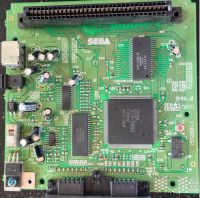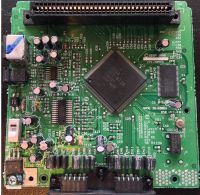Genesis:Model 3 Information: Difference between revisions
(Page Creation) |
mNo edit summary |
||
| Line 1: | Line 1: | ||
The Genesis 3 was | The Genesis 3 was marketed and assembled by Majesco Entertainment in 1998 under license from Sega (who also designed the console). It is a downscaled budget-friendly revision of the Genesis hardware, and was only released in North America. | ||
[[File:Sega-Genesis-3-Console-FL-300x233.jpg]] | [[File:Sega-Genesis-3-Console-FL-300x233.jpg]] | ||
| Line 9: | Line 9: | ||
=== VA1 === | === VA1 === | ||
This variant is smaller than, but similar to the VA4 revision of the Genesis Model 2. It is missing specific connections from the GOAC (Genesis on a Chip) to the cartridge slot. This prevents compatibility with the | This variant is smaller than, but similar to the VA4 revision of the Genesis Model 2. It is missing specific connections from the GOAC (Genesis on a Chip) to the cartridge slot. This prevents compatibility with the 32X, Power Base Converter, Virtua Racing and Game Genie. It is possible to restore these connections with modification. Further information on this mod and instructions can be found here. | ||
[[File:Genesis3MotherboardVA1.jpeg|200px]] | [[File:Genesis3MotherboardVA1.jpeg|200px]] | ||
=== VA2 === | === VA2 === | ||
This variant has a different chip layout than the VA1. It is missing the same cartridge slot connections mentioned above. However, it is not possible to restore all of them on this revision. It is believed that this is because the needed signals have been completely removed from the GOAC on this board. As a result, only Virtua Racing and Game Genie compatibility can be restored on the VA2. You can find instructions for this mod here. In addition, the VA2 received a fix to a long-standing bug in the TAS (Test and Set) instruction. The bug had been present since the Model 1, and some games were programmed to use this incorrect TAS instruction. As a result, these games will not work correctly on this revision. The most notable of these titles is Gargoyles. | This variant has a different chip layout than the VA1. It is missing the same cartridge slot connections mentioned above. However, it is not possible to restore all of them on this revision. It is believed that this is because the needed signals have been completely removed from the GOAC on this board. As a result, only Virtua Racing and Game Genie compatibility can be restored on the VA2. You can find instructions for this mod here. In addition, the VA2 received a fix to a long-standing bug in the TAS (Test and Set) instruction. The bug had been present since the Model 1, and some games were programmed to use this incorrect TAS instruction. As a result, these games will not work correctly on this revision. The most notable of these titles is ''Gargoyles''. | ||
[[File:Genesis3MotherboardRevisions.jpg|200px]] | [[File:Genesis3MotherboardRevisions.jpg|200px]] | ||
| Line 22: | Line 22: | ||
[[File:GenesisCartridgePinout-1024x348.png|200px]]<ref>Sega-16 Forums</ref> | [[File:GenesisCartridgePinout-1024x348.png|200px]]<ref>Sega-16 Forums</ref> | ||
== Audio and Video Output Information == | == Audio and Video Output Information == | ||
All versions of the Genesis 3 output RGB video. A major drawback to this model is found in its audio output. It does not feature | All versions of the Genesis 3 output RGB video. A major drawback to this model is found in its audio output. It does not feature a headphone jack like the model 1, and without modification, only outputs mono sound. | ||
| Line 30: | Line 30: | ||
====Lifting the Subcarrier Pin==== | ====Lifting the Subcarrier Pin==== | ||
This involves lifting the subcarrier pin from the Video Display Processor (VDP) and will produce a noticeable RGB video improvement, but will | This involves lifting the subcarrier pin from the Video Display Processor (VDP) and will produce a noticeable RGB video improvement, but will disable color on the composite video signal. This is a relatively easy and simple modification. It doesn't bring as much improvement as the next option, but it is often considered a great first step. Detailed instructions on it can be found here. | ||
====RGB Triple Bypass==== | ====RGB Triple Bypass==== | ||
Revision as of 06:21, 24 October 2022
The Genesis 3 was marketed and assembled by Majesco Entertainment in 1998 under license from Sega (who also designed the console). It is a downscaled budget-friendly revision of the Genesis hardware, and was only released in North America.
Overview
The console has a significantly smaller and lighter design than its predecessors. Notably, it lacks several hardware features present on older models. These include the headphone jack, the EXT port, expansion port, power LED, and stereo sound. It is incompatible with the Sega CD, Sega 32X, and the Power Base Converter. There are also a number of game compatibility issues.
Motherboard Revisions
There are two versions of the Genesis 3 motherboard, the VA1, and VA2. The differences between the two are significant.
VA1
This variant is smaller than, but similar to the VA4 revision of the Genesis Model 2. It is missing specific connections from the GOAC (Genesis on a Chip) to the cartridge slot. This prevents compatibility with the 32X, Power Base Converter, Virtua Racing and Game Genie. It is possible to restore these connections with modification. Further information on this mod and instructions can be found here.
VA2
This variant has a different chip layout than the VA1. It is missing the same cartridge slot connections mentioned above. However, it is not possible to restore all of them on this revision. It is believed that this is because the needed signals have been completely removed from the GOAC on this board. As a result, only Virtua Racing and Game Genie compatibility can be restored on the VA2. You can find instructions for this mod here. In addition, the VA2 received a fix to a long-standing bug in the TAS (Test and Set) instruction. The bug had been present since the Model 1, and some games were programmed to use this incorrect TAS instruction. As a result, these games will not work correctly on this revision. The most notable of these titles is Gargoyles.
Cartridge Pinout
Audio and Video Output Information
All versions of the Genesis 3 output RGB video. A major drawback to this model is found in its audio output. It does not feature a headphone jack like the model 1, and without modification, only outputs mono sound.
RGB Output Mods
The video output of the Genesis 3 is extremely high in quality. An unmodified unit outputs a better signal than most previous Genesis revisions. That said, there are a few different hardware modifications that can be made to improve the signal even further.
Lifting the Subcarrier Pin
This involves lifting the subcarrier pin from the Video Display Processor (VDP) and will produce a noticeable RGB video improvement, but will disable color on the composite video signal. This is a relatively easy and simple modification. It doesn't bring as much improvement as the next option, but it is often considered a great first step. Detailed instructions on it can be found here.
RGB Triple Bypass
The “Triple Bypass” (3BP for short) is a board that contains both video and audio amplifiers, installing it bypasses the onboard circuits on the Genesis 3 for these instead. This will give you near-perfect video and audio output. Installation instructions can be found here.
Audio Output Mods
As mentioned, the Genesis 3 only outputs mono audio. This is a major downgrade from previous models. There are multiple options for modifying the hardware to restore stereo sound.
The Mega Amp 2.0
This is a universal replacement audio amp for the Sega Genesis. This option only affects the audio and doesn't touch the video output. Because of this, it is only recommended as an option for situations where you want to keep the composite video intact or use the original unmodified RGB signal. For information and instructions can be found here.
RGB Triple Bypass
The same modification is listed above for video output. This board bypasses the audio and video circuits on the Genesis 3. It features an integrated Mega Amp 2.0. However, it does sacrifice the original composite video output. It is generally considered the superior option unless composite video needs to be retained. installation instructions can be found here.
- ↑ Sega-16 Forums



